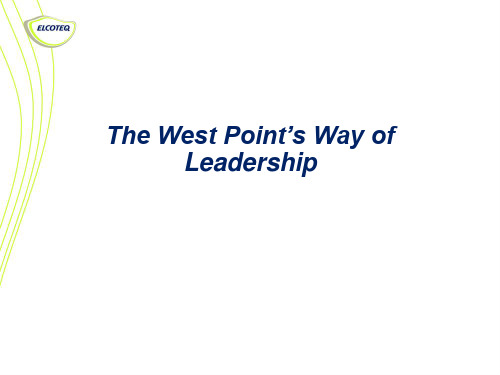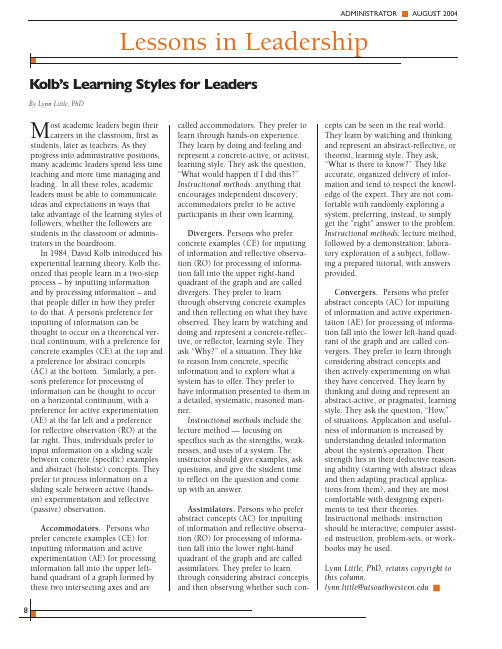styless of leadership
- 格式:ppt
- 大小:1.26 MB
- 文档页数:25



likert’s four styles of leadership“likert’s four styles of leadership”中文翻译:莱克特的四种领导风格。
莱克特的四种领导风格是指将Rensis Likert提出的关于领导风格的理论从其原始语言翻译成其他语言的过程。
Rensis Likert是一位美国心理学家和管理理论家,他提出了一个理论,描述了管理者用来有效领导团队的四种不同的领导风格。
这些风格包括:1. 剥削型权威(系统1):这种风格特征是高度集中的权力结构,决策由高层管理人员做出,下属在决策过程中几乎没有发言权。
沟通只从上到下流动,管理者与员工之间的互动极少。
这种风格被认为是长期组织成功的无效方式,因为它导致员工士气低落、工作满意度低,并且可能导致高员工流失率。
2. 仁慈型权威(系统2):这种风格与系统1相似,但管理者对员工有更多的个人关怀。
虽然决策仍然是由高层管理人员做出的,但他们可能会考虑员工的意见和福祉。
这种风格比系统1更有效,但仍存在沟通不足和员工参与度低的问题。
3. 协商式(系统3):在协商式领导风格中,管理者与员工之间的沟通更加双向。
决策过程中会征求员工的意见,并且鼓励员工参与决策。
这种风格提高了员工的参与度和满意度,有助于提高组织效率。
4. 员工中心化(系统4):这是最有效的领导风格,特征是高度的员工参与和民主化的决策过程。
管理者和员工之间有广泛的沟通和互动,员工在决策过程中有很大的影响力。
这种风格促进了团队合作、创新和组织承诺,通常与高绩效相关联。
莱克特的四种领导风格理论强调了不同领导风格对组织绩效的影响,并认为系统4是最理想的领导风格,因为它能够激发员工的潜力并促进组织的整体成功。

ADMINISTRATORAUGUST 2004M ost academic leaders begin theircareers in the classroom, first asstudents, later as teachers. As theyprogress into administrative positions,many academic leaders spend less timeteaching and more time managing andleading. In all these roles, academicleaders must be able to communicateideas and expectations in ways thattake advantage of the learning styles offollowers, whether the followers arestudents in the classroom or adminis-trators in the boardroom.In 1984, David Kolb introduced hisexperiential learning theory . Kolb the-orized that people learn in a two-stepprocess – by inputting informationand by processing information – andthat people differ in how they preferto do that. A person’s preference forinputting of information can bethought to occur on a theoretical ver-tical continuum, with a preference forconcrete examples (CE) at the top anda preference for abstract concepts(AC) at the bottom. Similarly , a per-son’s preference for processing ofinformation can be thought to occuron a horizontal continuum, with apreference for active experimentation(AE) at the far left and a preferencefor reflective observation (RO) at thefar right. Thus, individuals prefer toinput information on a sliding scalebetween concrete (specific) examplesand abstract (holistic) concepts. Theyprefer to process information on asliding scale between active (hands-on) experimentation and reflective(passive) observation.Accommodators. Persons whoprefer concrete examples (CE) forinputting information and activeexperimentation (AE) for processinginformation fall into the upper left-hand quadrant of a graph formed bythese two intersecting axes and are called accommodators. They prefer to learn through hands-on experience.They learn by doing and feeling and represent a concrete-active, or activist,learning style. They ask the question,“What would happen if I did this?”Instructional methods:anything that encourages independent discovery;accommodators prefer to be active participants in their own learning.Divergers.Persons who prefer concrete examples (CE) for inputting of information and reflective observa-tion (RO) for processing of informa-tion fall into the upper right-hand quadrant of the graph and are called divergers. They prefer to learn through observing concrete examples and then reflecting on what they have observed. They learn by watching and doing and represent a concrete-reflec-tive, or reflector, learning style. They ask “Why?” of a situation. They like to reason from concrete, specific information and to explore what a system has to offer. They prefer to have information presented to them in a detailed, systematic, reasoned man-ner.Instructional methods include the lecture method — focusing on specifics such as the strengths, weak-nesses, and uses of a system. The instructor should give examples, ask questions, and give the student time to reflect on the question and come up with an answer.Assimilators.Persons who prefer abstract concepts (AC) for inputting of information and reflective observa-tion (RO) for processing of informa-tion fall into the lower right-hand quadrant of the graph and are called assimilators. They prefer to learn through considering abstract concepts and then observing whether such con-cepts can be seen in the real world.They learn by watching and thinking and represent an abstract-reflective, or theorist, learning style. They ask,“What is there to know?” They like accurate, organized delivery of infor-mation and tend to respect the knowl-edge of the expert. They are not com-fortable with randomly exploring a system, preferring, instead, to simply get the “right” answer to the problem.Instructional methods:lecture method,followed by a demonstration; labora-tory exploration of a subject, follow-ing a prepared tutorial, with answers provided.Convergers. Persons who prefer abstract concepts (AC) for inputting of information and active experimen-tation (AE) for processing of informa-tion fall into the lower left-hand quad-rant of the graph and are called con-vergers. They prefer to learn through considering abstract concepts and then actively experimenting on what they have conceived. They learn by thinking and doing and represent an abstract-active, or pragmatist, learning style. They ask the question, “How ,”of situations. Application and useful-ness of information is increased by understanding detailed information about the system’s operation. Their strength lies in their deductive reason-ing ability (starting with abstract ideas and then adapting practical applica-tions from them), and they are most comfortable with designing experi-ments to test their theories.Instructional methods: instruction should be interactive; computer assist-ed instruction, problem-sets, or work-books may be used.L ynn Little, PhD, retains copyright to this column.lynn.little@ K olb’s Learning Styles for LeadersBy Lynn Little, PhD。


Lea ders hip Style sLeadership style is the manner and approach of providing direction, implementing plans, and motivating people. There are normally three styles of leadership (U.S. Army Handbook, 1973) :o Authoritarian or autocratico Participative or democratico Delegative or Free ReignAlthough good leaders use all three styles, with one of them normally dominate, bad leaders tend to stick with one style.A u t h o r i t a r i a n(a u t o c r a t i c)专治管理:This style is used when the leader tells her employees what she wants done and how she wants it done, without getting the advice of her followers. Some of the appropriate conditions to use it is when you have all the information to solve the problem, you are short on time, and your employees are well motivated.没有提前询问成员的意见,当管理者只是告诉成员他们应该怎么做、如何做。
当我们有绝对的信息处理问题、紧急情况下、或者你的成员工作意愿较高时。
The Four Leadership StylesDirections: Read the following descriptions of the four leadership styles. Which best describes you as a leader? Note the contexts where you minister best and the strengths that you bring to that context or situation. Also, be aware of your weaknesses.Directors (The Strong Leadership Style)Context. Directors are task-oriented leaders. As such, they bring this strength to ministries that need more task orientation.Strengths. Directors excel at the task-oriented aspects of leadership. Some are visionaries and most set lofty goals for their ministries and regularly challenge people to accomplish those goals. They’re change agents who question the status quo and may struggle with maintaining traditions. They tend to be point pastors in their churches and are often involved in leading church planting and refocusing efforts.Weaknesses. While Directors are strong, task-oriented leaders, they often struggle with the relational side of leadership. They have to resist the temptation to take control of a ministry and to work around rather than with a ministry team.Inspirationals (The Personable Leadership Style)Context. Inspirationals are people-oriented leaders that bring this strength to ministries that need a more relational orientation. Like the Directors, they often gravitate to lead positions, especially in church contexts.Strengths. Some temperament tools call Inspirational leaders influencers because they tend to be natural born leaders, especially in relating well to people. Thus, they, too, often lead church planting and refocusing efforts.Weaknesses. However, some Inspirationals can be loud and obnoxious. They enjoy being the center of attention, and that often bothers followers. While Inspirationals are strong relationally, they may struggle at accomplishing necessary leadership tasks and may prove to be weak at administration.Diplomats. (The Supportive Leadership Style)Context. Diplomats are people-oriented leaders who, like the Inspirationals, bring a more relational orientation to the ministry context. They lead best in situations that call for a person that is caring, supportive, friendly, and patient They prefer a slower ministry pace and resist change environments because they’re concerned about the risks change brings and how it will affect people.Strengths. Other leaders praise Diplomats for their loyalty and support, especially in difficult times. They are great team players that cooperate well with their teammates in accomplishing ministry tasks.Weaknesses. Some people complain that Diplomats are so nice that it’s hard to be angry with them when you need to be-you don’t want to hurt their feelings. Diplomats would benefit by being more proactive and taking the initiative in ministry opportunities.Analyticals(The Conscientious Leadership Style)Context. Analyticals are task-oriented leaders. Thus, they can bring certain complementary, task-oriented abilities to their ministry contexts. They lead well in ministry situations calling for people that are analytical, factual, probing, detail oriented, and that demand high quality. An example is an academic or teaching setting such as a Bible college or seminary classroom. They also function well as lead pastors of churches that emphasize a strong pulpit characterized by deep Bible teaching, the teacher-pastor model.Strengths. Analyticals are conscientious, self disciplined leaders that are self-starters. They are good at evaluating their church and ministry programs and holding churches to their theological moorings. Some people are attracted to Analyticals for their careful, accurate Bible teaching. Analyticals who preach prefer to cover the Bible in depth, using lots of facts and details to support their conclusions.Weaknesses. In their leadership roles, Analyticals attempt to maintain the status quo or even look to the past and tradition for direction. Consequently, they may not see the need to move into the future and consider new ministry approaches. Analyticals have a tendency to be critical of innovative leaders that do ministry differently, and they may even stir up negative feelings toward them. They would benefit much by developing strong relational ministry skills with their staff and congregation.These leadership styles also combine to form at least sixteen different styles. For example, the Director style could have the following combinations: Director-Inspirational, Director-Diplomat, and Director-analytical. Perhaps you noted that you have a combination of two or possibly more styles.。